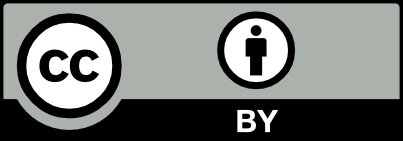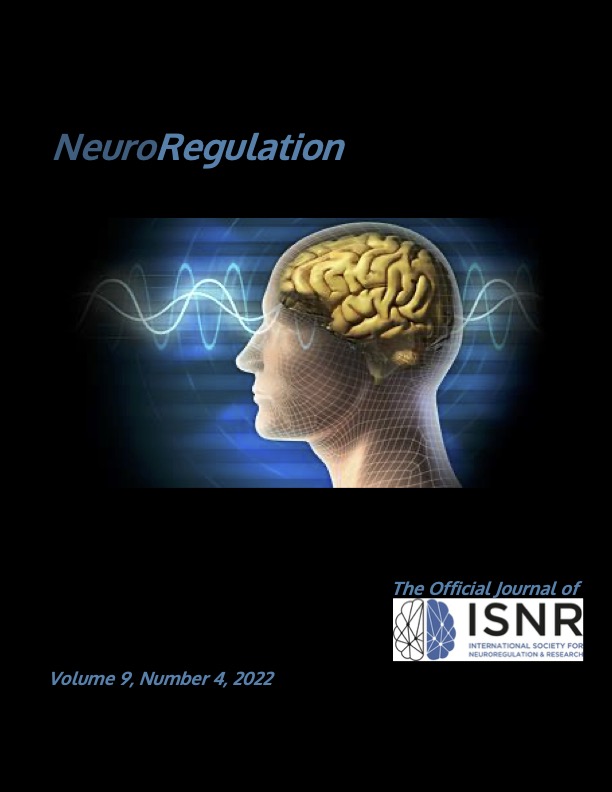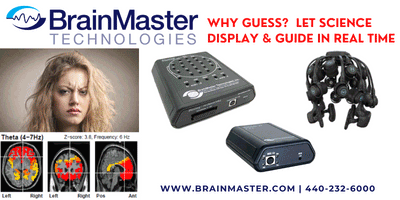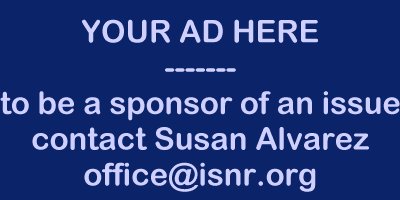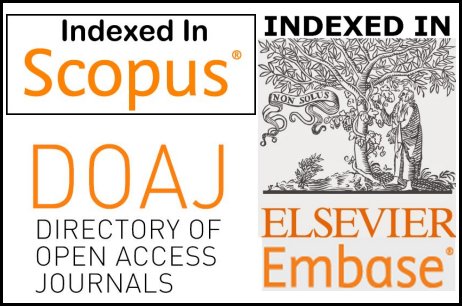Proceedings of the 2022 ISNR Annual Conference: Poster Presentations
DOI:
https://doi.org/10.15540/nr.9.4.198Keywords:
ISNR, conference proceedings, neurofeedback, qeeg, neuromodulation, neuroregulationAbstract
Abstracts of Poster presentations at the 2022 ISNR Annual Conference.
References
--QEEG Individualized Protocols for the Treatment of Alcohol Use Disorder
Da, B. L., Im, G. Y., & Schiano, T. D. (2020). Coronavirus Disease 2019 hangover: A rising tide of alcohol use disorder and alcohol-associated liver disease. Hepatology, 72(3), 1102–1108. https://doi.org/10.1002/hep.31307
Dousset, C., Kajosch, H., Ingels, A., Schröder, E., Kornreich, C., & Campanella, S. (2020). Preventing relapse in alcohol disorder with EEG-neurofeedback as a neuromodulation technique: A review and new insights regarding its application. Addictive Behaviors, 106, Article 106391. https://doi.org/10.1016/j.addbeh.2020.106391
Hammond, D. C. (2010). The need for individualization in neurofeedback: Heterogeneity in QEEG patterns associated with diagnoses and symptoms. Applied Psychophysiology and Biofeedback, 35(1), Article 31. https://doi.org/10.1007/s10484-009-9106-1
Hammond, D. C., Walker, J., Hoffman, D., Lubar, J. F., Trudeau, D., Gurnee, R., & Horvat, J. (2004). Standards for the use of quantitative electroencephalography (QEEG) in neurofeedback: A position paper of the International Society for Neuronal Regulation. Journal of Neurotherapy, 8(1), 5–27. https://doi.org/10.1300/J184v08n01_02
Peniston, E. G., & Kulkosky, P. J. (1989). Alpha-theta-brainwave training and beta-endorphin levels in alcoholics. Alcoholism-Clinical and Experimental Research, 13(2), 271–279. https://doi.org/10.1111/j.1530-0277.1989.tb00325.x
Peniston, E. G., & Kulkosky, P. J. (1990). Alcoholic personality and alpha-theta brainwave training. Medical Psychotherapy: An International Journal, 3, 37–55.
Saunders, J. B., Aasland, O. G., Babor, T. F., de La Fuente, J. R., & Grant, M. (1993). Development of the alcohol use disorders identification test (AUDIT): WHO collaborative project on early detection of persons with harmful alcohol consumption-II. Addiction, 88(6), 791–804. https://doi.org/10.1111/j.1360-0443.1993.tb02093.x
Scott, W., & Kaiser, D. (1998). Augmenting chemical dependency treatment with neurofeedback training. Journal of Neurotherapy, 3(1), 66.
Sokhadze, T. M., Cannon, R. L., & Trudeau, D. L. (2008). EEG biofeedback as a treatment for substance use disorders: Review, rating of efficacy, and recommendations for further research. Applied Psychophysiology and Biofeedback, 33(1), 1–28. https://doi.org/10.1007/s10484-007-9047-5
Thatcher, R. W., Lubar, J. F., & Koberda, J. L. (2019). Z-Score EEG biofeedback: Past, present, and future. Biofeedback, 47(4), 89–103. https://doi.org/10.5298/1081-5937-47.4.04
--Comparison Between Audiovisual and Visual Beta Neurofeedback for Attention Enhancement
Chaney, W. R. (2005). Top-of-hour break renews attention span. Teaching Professor, 19(6), 1–5.
Hamid, A., Shahzad, T., Faridi, S., & Nadeem, A. (2020). Frequency of behavioural tendencies resembling attention-deficit hyperactivity disorders in undergraduate medical students: a cross sectional study. Journal of the Pakistan Medical Association, 70(9), 1671–1675. https://doi.org/10.5455/jpma.35012
Hunkin, H., King, D. L., & Zajac, I. T. (2021). EEG neurofeedback during focused attention meditation: Effects on state mindfulness and meditation experiences. Mindfulness, 12(4), 841–851. https://doi.org/10.1007/s12671-020-01541-0
Jurewicz, K., Paluch, K., Kublik, E., Rogala, J., Mikicin, M., & Wróbel, A. (2018). EEG-neurofeedback training of beta band (12–22 Hz) affects alpha and beta frequencies—A controlled study of a healthy population. Neuropsychologia, 108, 13–24. https://doi.org/10.1016/j.neuropsychologia.2017.11.021
Thomas, K. P., Vinod, A. P., & Guan, C. (2013). Design of an online EEG based neurofeedback game for enhancing attention and memory. 2013 35th Annual International Conference of the IEEE Engineering in Medicine and Biology Society (EMBC), 433–436. https://doi.org/10.1109/embc.2013.6609529
--Dynamics of the Psycho-Emotional State and fMRI Neuroimaging During Biofeedback Training Course
Berman, M. G., Jonides, J., & Nee, D. E. (2006). Studying mind and brain with fMRI. Social Cognitive and Affective Neuroscience, 1(2), 158–161. https://doi.org/10.1093/scan/nsl019
Jafarova, O., Mazhirina, K., Sokhadze, E., & Shtark, M. (2020). Self-regulation strategies and heart rate biofeedback training. Applied Psychophysiology and Biofeedback, 45(2), 87–98. https://doi.org/10.1007/s10484-020-09460-5
Mazhirina, K. G., Jafarova, O. A., Pervushina, O. N., & Redko, N. G. (2010). The development and mastering of the skills of self-regulation in the course of game biofeedback: Psychological analysis. Bulletin of the Siberian Medicine, 9(2), 129–133. https://doi.org/10.20538/1682-0363-2010-2-129-133
Shtark, M. B., Mazhirina, K., Rezakova, M., Savelov, A., Pokrovsky, M., & Jafarova, O. (2014). Neuroimaging phenomenology of the central self-regulation mechanisms. Journal of Behavioral and Brain Science, 4(1), 58–68. https://doi.org/10.4236/jbbs.2014.41008
--Real-Time fMRI-EEG Neurofeedback for Stroke Rehabilitation
Emmert, K., Kopel, R., Sulzer, J., Brühl, A. B., Berman, B. D., Linden, D. E. J., Horovitz, S. G., Breimhorst, M., Caria, A. Frank, S., Johnston, S., Long, Z., Pare, C., Robineau, F., Veit, R., Bartsch, A., Beckmann, C. F., … & Haller, S. (2016). Meta-analysis of real-time fMRI neurofeedback studies using individual participant data: How is brain regulation mediated? NeuroImage, 124(Part A), 806–812. https://doi.org/10.1016/j.neuroimage.2015.09.042
Kilner, J. M., Mattout, J., Henson, R., & Friston, K. J. (2005). Hemodynamic correlates of EEG: A heuristic. NeuroImage, 28(1), 280–286. https://doi.org/10.1016/j.neuroimage.2005.06.008
Marecek, R., Lamos, M., Mikl, M., Barton, M., Fajkus, J., Rektor, I., & Brazdil, M. (2016). What can be found in scalp EEG spectrum beyond common frequency bands. EEG-fMRI study. Journal of Neural Engineering, 13(4), Article 046026. https://doi.org/10.1088/1741-2560/13/4/046026
Meir-Hasson, Y., Kinreich, S., Podlipsky, I., Hendler, T., & Intrator, N. (2014). An EEG finger-print of fMRI deep regional activation. NeuroImage, 102(Part 1), 128–141. https://doi.org/10.1016/j.neuroimage.2013.11.004
Murta, T., Leite, M., Carmichael, D. W., Figueiredo, P., & Lemieux, L. (2015). Electrophysiological correlates of the BOLD signal for EEG-informed fMRI. Human Brain Mapping, 36(1), 391–414. https://doi.org/10.1002/hbm.22623
Rosa, M. J., Daunizeau, J., & Friston, K. J. (2010). EEG-fMRI integration: A critical review of biophysical modeling and data analysis approaches. Journal of Integrative Neuroscience, 9(4), 453–476. https://doi.org/10.1142/s0219635210002512
Rudnev, V., Melnikov, M., Savelov, A., Shtark, M., & Sokhadze, E. (2021). fMRI-EEG fingerprint regression model for motor cortex. NeuroRegulation, 8(3), 162–172. https://doi.org/10.15540/nr.8.3.162
--Braingomo: An Innovative Smartphone-Based Neurofeedback Platform
Arns, M., Heinrich, H., & Strehl, U. (2014). Evaluation of neurofeedback in ADHD: The long and winding road. Biological Psychology, 95, 108–115. https://doi.org/10.1016/j.biopsycho.2013.11.013
Bussalb, A., Congedo, M., Barthélemy, Q., Ojeda, D., Acquaviva, E., Delorme, R., & Mayaud, L. (2019). Clinical and experimental factors influencing the efficacy of neurofeedback in ADHD: A meta-analysis. Frontiers in Psychiatry, 10, 35. https://doi.org/10.3389/fpsyt.2019.00035
Chen, S.-M., Ramachandran, R., Mani, V., & Saraswathi, R. (2014). Recent advancements in electrode materials for the high-performance electrochemical supercapacitors: A review. International Journal of Electrochemical Science, 9(8), 4072–4085.
Cortese, S., Ferrin, M., Brandeis, D., Holtmann, M., Aggensteiner, P., Daley, D., Santosh, P., Simonoff, E., Stevenson, J., Stringaris, A., Sonuga-Barke, E. J. S., & European ADHD Guidelines Group (EAGG). (2016). Neurofeedback for attention-deficit/hyperactivity disorder: Meta-analysis of clinical and neuropsychological outcomes from randomized controlled trials. Journal of the American Academy of Child & Adolescent Psychiatry, 55(6), 444–455. https://doi.org/10.1016/j.jaac.2016.03.007
Kadosh, K. C., & Staunton, G. (2019). A systematic review of the psychological factors that influence neurofeedback learning outcomes. NeuroImage, 185, 545–555. https://doi.org/10.1016/j.neuroimage.2018.10.021
Marzbani, H., Marateb, H. R., & Mansourian, M. (2016). Neurofeedback: A comprehensive review on system design, methodology and clinical applications. Basic and Clinical Neuroscience, 7(2), 143–158. https://doi.org/10.15412/J.BCN.03070208
Van Doren, J., Arns, M., Heinrich, H., Vollebregt, M. A., Strehl, U., & Loo, S. (2019). Sustained effects of neurofeedback in ADHD: A systematic review and meta-analysis. European Child & Adolescent Psychiatry, 28(3), 293–305. https://doi.org/10.1007/s00787-018-1121-4
--QEEG-Guided sLORETA Neurofeedback Effects on Event-Related Potentials and Cognitive Performance on a Stroke Sufferer: A Case Study
Kober, S. E., Schweiger, D., Reichert, J. L., Neuper, C., & Wood, G. (2017). Upper alpha based neurofeedback training in chronic stroke: Brain plasticity processes and cognitive effects. Applied Psychophysiology and Biofeedback, 42(1), 69–83. https://doi.org/10.1007/s10484-017-9353-5
Kober, S. E., Schweiger, D., Witte, M., Reichert, J. L., Grieshofer, P., Neuper, C., & Wood, G. (2015). Specific effects of EEG based neurofeedback training on memory functions in post-stroke victims. Journal of NeuroEngineering and Rehabilitation, 12, Article 107. https://doi.org/10.1186/s12984-015-0105-6
Koberda, L. (2015). LORETA Z-score neurofeedback effectiveness in rehabilitation of patients suffering from Traumatic Brain Injury. Journal of Neurology and Neurobiology, 1(4). https://doi.org/10.16966/2379
Koberda, L., Koberda, P., Moses, A., Winslow, J., Bienkiewicz, A., & Koberda, L. (2014). Z-score LORETA neurofeedback as a potential therapy for ADHD. Biofeedback, 42(2), 74–81 https://doi.org/10.5298/1081-5937-42.2.05
Koberda, J. L., & Stodolska-Koberda, U. (2014). Z-score LORETA Neurofeedback as a potential rehabilitation modality in patients with CVA. Journal of Neurology & Stroke, 1(5), 00029. https://doi.org/10.15406/jnsk.2014.01.00029
Mihara, M., Fujimoto, H., Hattori, N., Otomune, H., Kajiyama, Y., Konaka, K., Watanabe, Y., Hiramatsu, Y., Sunada, Y., Miyai, I., & Mochizuki, H. (2021). Effect of neurofeedback facilitation on poststroke gait and balance recovery: A randomized controlled trial. Neurology, 96(21), e2587–e2598. https://doi.org/10.1212/WNL.0000000000011989
--Effect of TMS on EEG Biomarker in a Patient with PTSD Performance on a Stroke Sufferer: A Case Study
Duvinage, M., Castermans, T., Petieau, M., Hoellinger, T., Cheron, G., & Dutoit, T. (2013). Performance of the Emotiv Epoc headset for P300-based applications. BioMedical Engineering OnLine, 12(1), Article 56. https://doi.org/10.1186/1475-925X-12-56
Jonas, D. E., Cusack, K., Forneris, C. A., Wilkins, T. M., Sonis, J., Middleton, J. C., Feltner, C., Meredith, D., Cavanaugh, J., Brownley, K. A., Olmsted, K. R., Greenblatt, A., Weil, A., & Gaynes, B. N. (2013). Psychological and pharmacological treatments for adults with posttraumatic stress disorder (PTSD) [Internet]. Rockville (MD): Agency for Healthcare Research and Quality (US), (Report No.: 13-EHC011-EF.), 3–8. https://www.ncbi.nlm.nih.gov/books/NBK137691/
Sendi, M. S. E., Inman, C. S., Bijanki, K. R., Blanpain, L., Park, J. K., Hamann, S., Gross, R. E., Willie, J. T., & Mahmoudi, B. (2021). Identifying the neurophysiological effects of memory-enhancing amygdala stimulation using interpretable machine learning. Brain Stimulation, 14(6), 1511–1519. https://doi.org/10.1016/j.brs.2021.09.009
Yehuda, R., Hoge, C. W., McFarlane, A. C., Vermetten, E., Lanius, R. A., Nievergelt, C. M., Hobfoll, S. E., Koenen, K. C., Neylan, T. C., & Hyman, S. E. (2015). Post-traumatic stress disorder. Nature Reviews Disease Primers, 1(October), Article 15057. https://doi.org/10.1038/nrdp.2015.57
Zandvakili, A., Philip, N. S., Jones, S. R., Tyrka, A. R., Greenberg, B. D., & Carpenter, L. L. (2019). Use of machine learning in predicting clinical response to transcranial magnetic stimulation in comorbid posttraumatic stress disorder and major depression: A resting state electroencephalography study. Journal of Affective Disorders, 252(March), 47–54. https://doi.org/10.1016/j.jad.2019.03.077
--Loreta Z-Score Neurofeedback in Nine Clients with Anxiety and Posterior Cingulated Deviations
Drobnjak, S. (2013). Brief symptom inventory. In M. D. Gellman & J. R. Turner (Eds.), Encyclopedia of behavioral medicine (pp. 269–270). Springer New York. https://doi.org/10.1007/978-1-4419-1005-9_3
Duric, N. S., Assmus, J., Gundersen, D., & Elgen, I. B. (2012). Neurofeedback for the treatment of children and adolescents with ADHD: a randomized and controlled clinical trial using parental reports. BMC Psychiatry, 12, Article 107. https://doi.org/10.1186/1471-244X-12-107
Koberda, J. L. (2015). LORETA Z-score neurofeedback-effectiveness in rehabilitation of patients suffering from traumatic brain injury. Journal of Neurology and Neurobiology, 1(4). https://doi.org/10.16966/2379-7150.113
Koberda, J. L., Koberda, P., Moses, A., Winslow, J., Bienkiewicz, A., & Koberda, L. (2014). Z-Score LORETA neurofeedback as a potential therapy for ADHD. Biofeedback, 42(2), 74–81. https://doi.org/10.5298/1081-5937-42.2.05
Ros, T., Enriquez-Geppert, S., Zotev, V., Young, K. D., Wood, G., Whitfield-Gabrieli, S., Wan, F., Vuilleumier, P., Vialatte, F., Van De Ville, D., Todder, D., Surmeli, T., Sulzer, J. S., Strehl, U., Sterman, M. B., Steiner, N. J., Sorger, B., Soekadar, S. R., Sitaram, R., Sherlin, L. H., … Thibault, R. T. (2019, January 23). Consensus on the reporting and experimental design of clinical and cognitive-behavioural neurofeedback studies (CRED-nf checklist). Brain, 143(6), 1674–1685. https://doi.org/10.1093/brain/awaa009
Thatcher, R. W. (2013). Latest developments in live Z-Score training: Symptom check list, phase reset, and Loreta Z-Score biofeedback. Journal of Neurotherapy, 17(1), 69–87. https://doi.org/10.1080/10874208.2013.759032
Thatcher, R. W., & Lubar, J. F. (Eds.) (2015). Z Score neurofeedback: Clinical applications. Academic Press.
Thatcher, R. W., North, D., & Biver, C. (2005). Evaluation and validity of a LORETA normative EEG database. Clinical EEG and Neuroscience, 36(2), 116–122. https://doi.org/10.1177/155005940503600211
Thatcher, R. W., Walker, B. A., Biver, C. J., North, D. M., & Curtin, R. (2003). Sensitivity and specificity of an EEG database: Validation and clinical correlation. Journal of Neurotherapy, 7(3/4), 87–121.
Wigton, N. L. (2013, 2013/10/01). Clinical perspectives of 19-channel Z-Score neurofeedback: Benefits and limitations. Journal of Neurotherapy, 17(4), 259–264. https://doi.org/10.1080/10874208.2013.847142
Wigton, N., & Krigbaum, G. (2015, 08/10). A review of qEEG-guided neurofeedback. NeuroRegulation, 2(3), 149–155. https://doi.org/10.15540/nr.2.3.149
--The Application of Biofeedback and Neurofeedback in Underserved Children and Adolescents in Pediatric Neurology
Antle, A. N., Chesick, L., Sridharan, S. K., & Cramer, E. (2018). East meets west: a mobile brain-computer system that helps children living in poverty learn to self-regulate. Personal and Ubiquitous Computing, 22, 839–866. https://doi.org/10.1007/s00779-018-1166-x
Antle, A. N., McLaren, E. S., Fiedler, H., & Johnson, N. (2019). Evaluating the impact of a mobile neurofeedback app for young children at school and home. In Proceedings of the 2019 CHI Conference on Human Factors in Computing Systems (CHI '19). Association for Computing Machinery: New York, NY. https://doi.org/10.1145/3290605.3300266
Caporino, N. E., Chen, J. I., & Karver, M. S. (2014). Preliminary examination of ethnic group differences in adolescent girls' attitudes toward depression treatments. Cultural Diversity & Ethnic Minority Psychology, 20(1), 37–42. https://doi.org/10.1037/a0033467
DeBarros, A. M. V. (2020). Examining psychotherapeutic treatment approach preference in a Hispanic population. ProQuest Dissertations & Theses Global. https://scholarsarchive.byu.edu/etd/8762
Gooch, L., Pracht, E., & Borenstein, A. (2017). The burden of neurological disease in the United States: A summary report and call to action. Annals of Neurology, 81(4), 479–484. https://doi.org/10.1002/ana.24897
Kelley, M. (1997). Native Americans, neurofeedback, and substance abuse theory: Three year outcome of alpha/theta neurofeedback training in the treatment of problem drinking among Dine' (Navajo) people. Journal of Neurotherapy, 2(3), 24–60. https://doi.org/10.1300/J184v02n03_03
Ngin, J. (2015). Increasing academic resilience among ethnic minorities by targeting test anxiety through biofeedback. ProQuest Dissertations & Theses Global. https://www.proquest.com/docview/1667950340/DD24DF36977B4494PQ/1?accountid =10226
Substance Abuse and Mental Health Services Administration (SAMHSA). Key substance use and mental health indicators in the United States: results from the 2018 national survey on drug use and health. HHS Publication No. PEP19-5068, NSDUH Series H-54. Rockville, MD: SAMHSA, Center for Behavioral Health Statistics and Quality, 2019c.
Thorn, B. E., Day, M. A., Burns, J., Kuhajda, M. C., Gaskins, S. W., Sweeney, K., McConley, R., Ward, C. L., & Cabbil, C. (2011). Randomized trial of group cognitive behavioral therapy compared with a pain education control for low-literacy rural people with chronic pain. Pain, 152(12), 2710–2720. https://doi.org/10.1016/j.pain.2011.07.007
Weerdmeester, J., van Rooij, M. M. J. W., Engels, R. C. M. E., & Granic, I. (2020). An integrative model for the effectiveness of biofeedback interventions for anxiety regulation: Viewpoint. Journal of Medical Internet Research, 22(7), Article e14958. https://doi.org/10.2196/14958
Zhu, J. M., Breslau, J., & McConnell, K. J. (2021). Medicaid managed care network adequacy standards for mental health care access: Balancing flexibility and accountability. JAMA Health Forum, 2(5), Article e210280. https://doi.org/10.1001/jamahealthforum.2021.0280
--Power Spectrum Analysis in a SMR/Theta Neurofeedback Protocol Using Different Behavioral Strategies
Brickwedde, M., Krüger, M. C., & Dinse, H. R. (2019). Somatosensory alpha oscillations gate perceptual learning efficiency. Nature Communications, 10(1), Article 263. https://doi.org/10.1038/s41467-018-08012-0
Crivelli, D., Fronda, G., & Balconi, M. (2019). Neurocognitive enhancement effects of combined mindfulness—neurofeedback training in sport. Neuroscience, 412, 83–93. https://doi.org/10.1016/j.neuroscience.2019.05.066
Dessy, E., Mairesse, O., van Puyvelde, M., Cortoos, A., Neyt, X., & Pattyn, N. (2020). Train your brain? Can we really selectively train specific EEG frequencies with neurofeedback training. Frontiers in Human Neuroscience, 14, Article 22. https://doi.org/10.3389%2Ffnhum.2020.00022
Gonçalves, Ó. F., Carvalho, S., Mendes, A. J., Leite, J., & Boggio, P. S. (2018). Neuromodulating attention and mind-wandering processes with a single session real time EEG. Applied Psychophysiology and Biofeedback, 43(2), 143–151. https://doi.org/10.1007/s10484-018-9394-4
Gruzelier, J., Inoue, A., Smart, R., Steed, A., & Steffert, T. (2010). Acting performance and flow state enhanced with sensory-motor rhythm neurofeedback comparing ecologically valid immersive VR and training screen scenarios. Neuroscience Letters, 480(2), 112–116. https://doi.org/10.1016/j.neulet.2010.06.019
Jirayucharoensak, S., Israsena, P., Pan-ngum, S., Hemrungrojn, S., & Maes, M. (2019). A game-based neurofeedback training system to enhance cognitive performance in healthy elderly subjects and in patients with amnestic mild cognitive impairment. Clinical Interventions in Aging, 14, 347–360. https://doi.org/10.2147%2FCIA.S189047
Pei, G., Wu, J., Chen, D., Guo, G., Liu, S., Hong, M., & Yan, T. (2018). Effects of an integrated neurofeedback system with dry electrodes: EEG acquisition and cognition assessment. Sensors, 18(10), Article 3396. https://doi.org/10.3390%2Fs18103396
--Effect of Transcutaneous Electrical Nerve Stimulation of the Auricular Branch of the Vagus Nerve for the Treatment of Anxiety
Badran, B. W., Mithoefer, O. J., Summer, C. E., LaBate, N. T., Glusman, C. E., Badran, A. W., DeVries, W. H., Summers, P. M., Austelle, C. W., McTeague, L. M., Borckardt, J. J., & George, M. S. (2018). Short trains of transcutaneous auricular vagus nerve stimulation (taVNS) have parameter-specific effects on heart rate. Brain Stimulation, 11(4), 699–708. https://doi.org/10.1016/j.brs.2018.04.004
Busch, V., Zeman, F., Heckel, A., Menne, F., Ellrich, J., & Eichhammer, P. (2013). The effect of transcutaneous vagus nerve stimulation on pain perception—An experimental study. Brain Stimulation, 6(2), 202–209. https://doi.org/10.1016/j.brs.2012.04.006
Clancy, J. A., Mary, D. A., Witte, K. K., Greenwood, J. P., Deuchars, S. A., & Deuchars, J. (2014). Non-invasive vagus nerve stimulation in healthy humans reduces sympathetic nerve activity. Brain Stimulation, 7(6), 871–877. https://doi.org/10.1016/j.brs.2014.07.031
De Couck, M., Cserjesi, R., Caers, R., Zijlstra, W. P., Widjaja, D., Wolf, N., Luminet, O., Ellrich, J., & Gidron, Y. (2017). Effects of short and prolonged transcutaneous vagus nerve stimulation on heart rate variability in healthy subjects. Autonomic Neuroscience: Basic & Clinical, 203, 88–96. https://doi.org/10.1016/j.autneu.2016.11.003
Ginsberg, L. E., & Eicher, S. A. (2000). Great auricular nerve: Anatomy and imaging in a case of perineural tumor spread. American Journal of Neuroradiology, 21(3), 568–571.
Lamb, D. G., Porges, E. C., Lewis, G. F., & Williamson, J. B. (2017). Non-invasive vagal nerve stimulation effects on hyperarousal and autonomic state in patients with posttraumatic stress disorder and history of mild traumatic brain injury: Preliminary evidence. Frontiers in Medicine, 4, Article 124. https://doi.org/10.3389/fmed.2017.00124
Liu, D., & Hu, Y. (1988). The central projections of the great auricular nerve primary afferent fibers—An HRP transganglionic tracing method. Brain Research, 445(2), 205–210. https://doi.org/10.1016/0006-8993(88)91179-1
Warren, C. M., Tona, K. D., Ouwerkerk, L., van Paridon, J., Poletiek, F., van Steenbergen, H., Bosch, J. A., & Nieuwenhuis, S. (2019). The neuromodulatory and hormonal effects of transcutaneous vagus nerve stimulation as evidenced by salivary alpha-amylase, salivary cortisol, pupil diameter, and the P3 event-related potential. Brain Stimulation, 12(3), 635–642. https://doi.org/10.1016/j.brs.2018.12.224
Yakunina, N., Kim, S. S., & Nam, E.-C. (2017). Optimization of transcutaneous vagus nerve stimulation using functional MRI. Neuromodulation: Journal of the International Neuromodulation Society, 20(3), 290–300. https://doi.org/10.1111/ner.12541
Downloads
Published
Issue
Section
License
Authors who publish with this journal agree to the following terms:- Authors retain copyright and grant the journal right of first publication with the work simultaneously licensed under a Creative Commons Attribution License (CC-BY) that allows others to share the work with an acknowledgement of the work's authorship and initial publication in this journal.
- Authors are able to enter into separate, additional contractual arrangements for the non-exclusive distribution of the journal's published version of the work (e.g., post it to an institutional repository or publish it in a book), with an acknowledgement of its initial publication in this journal.
- Authors are permitted and encouraged to post their work online (e.g., in institutional repositories or on their website) prior to and during the submission process, as it can lead to productive exchanges, as well as earlier and greater citation of published work (See The Effect of Open Access).
